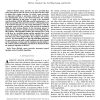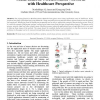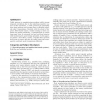131
Voted
JSAC
2010
14 years 7 months ago
2010
Robotic sensor networks are more powerful than sensor networks because the sensors can be moved by the robots to adjust their sensing coverage. In robotic sensor networks, an impor...
141
Voted
JSAC
2010
14 years 7 months ago
2010
Abstract--Sensor networks can benefit greatly from locationawareness, since it allows information gathered by the sensors to be tied to their physical locations. Ultra-wide bandwid...
120
Voted
JIPS
2010
14 years 7 months ago
2010
Wireless sensor networks consist of sensor nodes which are expected to be battery-powered and are hard to replace or recharge. Thus, reducing the energy consumption of sensor nodes...
128
Voted
ITIIS
2010
14 years 7 months ago
2010
Integrated RFID-WSNs (wireless sensor networks) have recently been researched to provide object identities, sensing information, mobile service, and network functionalities. In in...
135
Voted
WINET
2011
14 years 7 months ago
2011
Sleep scheduling, which is putting some sensor nodes into sleep mode without harming network functionality, is a common method to reduce energy consumption in dense wireless sensor...
139
Voted
IS
2011
14 years 7 months ago
2011
In order to process continuous queries over Wireless Sensor Networks (WSNs), sensors are typically organized in a Query Routing Tree (denoted as T) that provides each sensor with ...
121
Voted
IAJIT
2011
14 years 7 months ago
2011
: The recent advances in Wireless Sensor Networks have given rise to many application areas in healthcare. It has produced new field of Wireless Body Area Networks. Using wearable ...
123
Voted
IPSN
2010
Springer
14 years 9 months ago
2010
Springer
Traffic patterns in manufacturing machines exhibit strong temporal correlations due to the underlying repetitive nature of their operations. A MAC protocol can potentially learn t...
154
click to vote
ICDCS
2010
IEEE
14 years 10 months ago
2010
IEEE
Abstract--The networked application environment has motivated the development of multitasking operating systems for sensor networks and other low-power electronic devices, but thei...
124
Voted
GIS
2010
ACM
14 years 10 months ago
2010
ACM
Research on Moving Object Databases (MOD) has resulted in sophisticated query mechanisms for moving objects and regions. Wireless Sensor Networks (WSN) support a wide range of app...



